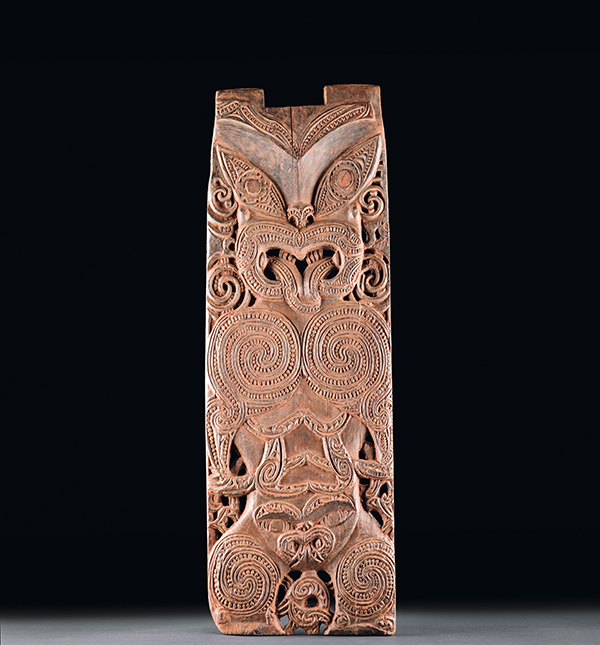By Michael Seifert
A globally unique wooden stele from the Maori culture in New Zealand is currently on display to the public for the first time in the Tübingen City Museum. The 32 x 90 centimeter carving is a Poupou (pronounced PaU-PaU) and represents a female ancestor figure. The famous British navigator and explorer James Cook brought it back with him from a voyage to England in 1771, during which he searched for the fifth continent, Australia, on behalf of the English king. Around 100 years earlier, Dutchmen had been the first Europeans to set foot on New Zealand, but this had been forgotten.
It is only partially possible to reconstruct how the piece came to the University of Tübingen. It must have come to Vienna and the naturalist Ferdinand von Hochstetter from the possession of one of Cook’s fellow travelers. His daughter gave it to the Tübingen ethnologist Augustin Krämer in 1937. In the 1990s, the ethnologist Volker Harms discovered it in the collection of the Institute of Ethnology under the roof of Hohentübingen Palace. After extensive research, he was able to clearly identify the poupou as an object from Cook’s expedition on the basis of a drawing from 1771. As the stele could not be displayed safely enough in the ethnological collection, it was previously kept in a safe at the university.
Harms also contacted the descendants of the original owners, the Maori of Tolaga Bay on New Zealand’s North Island, where Cook landed at the time. This also clarified the history and function of the stele. According to oral tradition, the poupou belonged to the Māori noblewoman named Hinematioro. It embodies an ancestor from her highly respected noble family and was housed in her ancestral home. Such a figure is regarded as a living person with whom the Maori can stay in contact through touch and in rituals. They even keep their family trees (called “whakapapa”) in their heads for centuries, as these are passed down in chants and recitations and are regarded as part of their own person.
Many members of the Maori consider Hinematioro and the Poupou to be their ancestors and have therefore repeatedly come to Tübingen to make contact with the ancestor through the figure. There was also an opportunity to do this in New Zealand itself in 2019, when the Poupou was loaned there to celebrate the 250th anniversary of Cook’s landing.
This also raised the question of whether the figurine should not be regarded as possible looted art, as having come into European possession unlawfully through violence, and should be returned. However, the members of the Tübingen Institute discovered on site that the majority of Maori tribal leaders regard the poupou as a gift to Cook and his crew and thus as the Maori’s first gift to the Europeans. They see the poupou as an ambassador for Maori in Europe, promoting respect and friendship. At the same time, they are also grateful that one of the oldest ethnographic testimonies of their culture and the only one from this period has been preserved in Tübingen. Other Maori representatives do not recognize the legality of the donation. They see James Cook and his landing as the beginning of colonialism in New Zealand and thus also the racism of the Europeans towards the Maori. As there are no written sources about a possible donation, these different oral traditions have persisted. Today, around 800,000 Maori live in New Zealand, which is around 15 percent of the population. They regard themselves as New Zealand’s first settlers, having arrived in several waves from Polynesia to uninhabited New Zealand from the 13th century onwards.
Information on the exhibition: “Royal Visit to the City Museum: The Maori Princess and James Cook”; exhibition from December 1, 2023 to February 25, 2024; Wednesday, Friday to Sunday 11 am to 5 pm, Thursday 11 am to 7 pm; Stadtmuseum Tübingen, Kornhausstraße 10; admission free.
Students of ethnology have researched the meaning, origin and journey of the Poupou and compiled the results in a small studio exhibition with text panels and audiovisual contributions in collaboration with the Stadtmuseum.
tun23120505
Das Poupou der Hinematioro, derzeit ausgestellt im Stadtmuseum Tübingen. Foto: Valentin Marquardt, MUT, Ethnologische Sammlung.
002232




